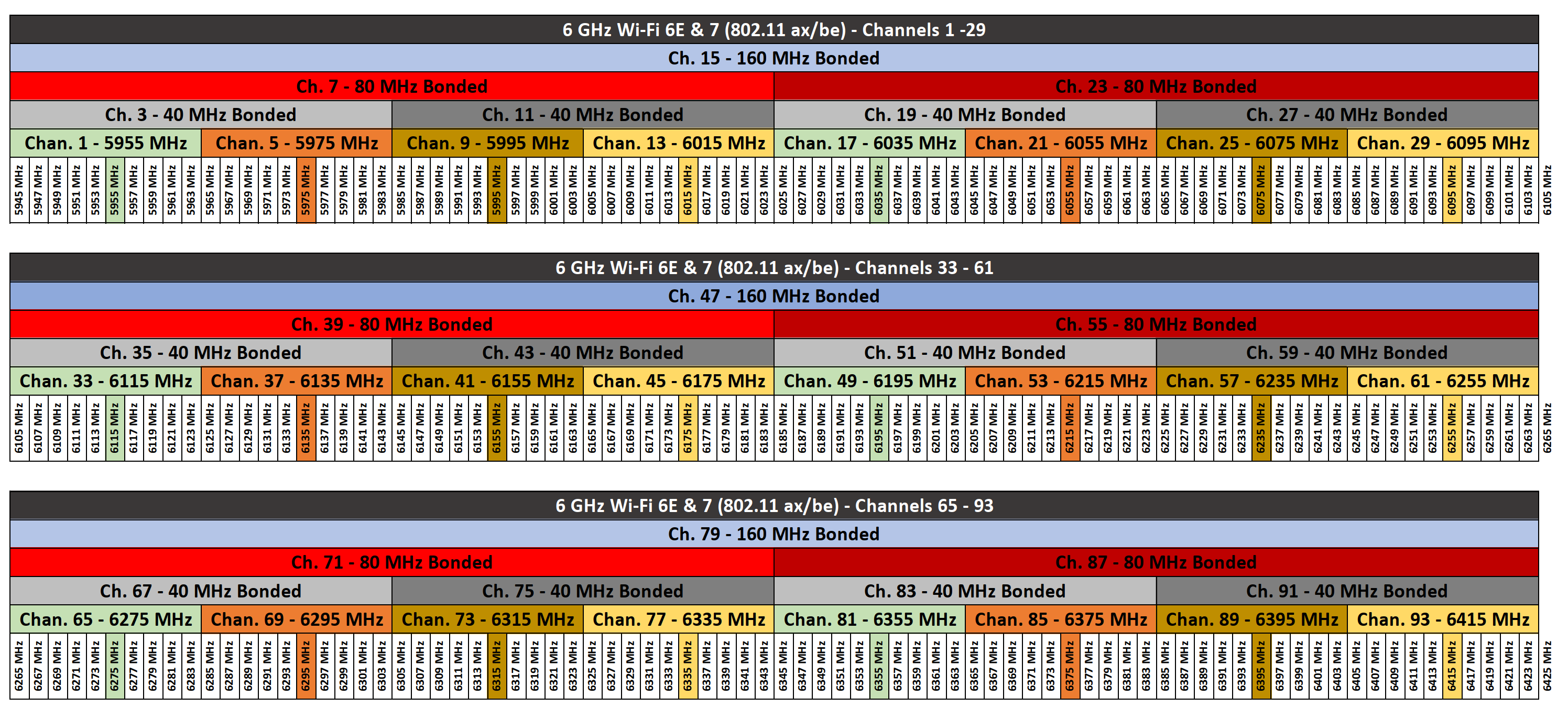Key Points:
- The newest Wi-Fi standard - Wi-Fi 7 - was formally approved in January 2024, bringing several key advancements to Wi-Fi technology
- Despite the arrival of Wi-Fi 7, Wi-Fi 6 and 6E will remain the most common standard supported by new gear in 2024.
- Wi-Fi 6E and Wi-Fi 7 can both take advantage of 6 GHz spectrum that vastly increases Wi-Fi capacity and speed.
Everyone loves Wi-Fi, which has almost become synonymous with the concept of having an internet connection.
But Wi-Fi doesn't magically connect you directly to the internet — it's a fundamental technology used to wirelessly connect your devices to some sort of router or access point that is connected to the internet.

This typically makes Wi-Fi a crucial piece of the connectivity chain involved in getting you and your devices online.
But Wi-Fi can be used for a lot more than Internet access. It also enables local connections—including between your devices and network storage devices, printers, smart TVs, and more.
Like all Internet-adjacent technologies, Wi-Fi is not static. The technology and standards behind the Wi-Fi advances over time to be more capable and robust, supporting ever-faster speeds and new capabilities.
With the new Wi-Fi 7 standard officially being released in January 2024, it's time to take a big-picture look at the current and near-future state of Wi-Fi for use in RVs, vans, and boats, and to give our recommendations for what to look for when shopping for new hardware.
Table of Contents
Wi-Fi Industry Update Video
Just What Is Wi-Fi?
"Wi-Fi" sounds like it should be an acronym, but it doesn't actually stand for anything specific. Wi-Fi was originally a play on "hi-fi" (high fidelity), an old term used in audio technology.
"Wi-Fi" is the friendly name for a set of wireless local networking standards and protocols created and controlled by the Wi-Fi Alliance, a trade association that promotes Wi-Fi technology and certifies Wi-Fi products for interoperability.

Wi-Fi is, by far, the dominant wireless technology for local area networking.
Instead of using wires, a Wi-Fi access point creates a local network by broadcasting over pre-defined wireless channels and then hosting a network that nearby devices can connect to if they know the network's name and password.
It's so popular and ubiquitous because it's wireless and generally reliable. But not all Wi-Fi is created equally. The older standards are less capable than newer standards.
Before the friendly Wi-Fi branding, these protocols were known by their more unfriendly and technical "IEEE 802.11" designations, which made it more difficult for consumers to compare devices and know what generation they were. Now, rather than looking for a device that supports 802.11ax, you can shop for "Wi-Fi 6."
For more on Wi-Fi basics, see our guide: Fundamentals of Wi-Fi Technology
Wi-Fi Frequency Bands
Most people who know the basics of Wi-Fi have heard about two different flavors of Wi-Fi — 2.4 GHz and 5 GHz.
These refer to two different sections of wireless spectrum that Wi-Fi uses. With the newer Wi-Fi 6E standard, a third piece of spectrum was added, 6 GHz - more on that later.
These are frequency bands specifically authorized by the FCC (and other regulatory agencies worldwide) for Wi-Fi signal broadcasts.
Unlike most other spectrum—including cellular, FM Radio, and many others—no one company owns an exclusive license to the spectrum used for Wi-Fi. This means that any manufacturer can build a Wi-Fi-compatible device, and all Wi-Fi networks in an area have to coexist and share the airwaves.
This openness is what allows Wi-Fi to be so ubiquitous.
This also means that Wi-Fi performance is much more subject to interference and congestion than other types of signals. In crowded conditions, when many Wi-Fi networks try to share limited slices of Wi-Fi spectrum, performance can suffer. However, newer standards are better at deconflicting between many devices, and new spectrum gets added to create more Wi-Fi lanes on the highway to ease congestion.
Here's a quick overview of the three frequency bands used for Wi-Fi today:
2.4 GHz Wi-Fi
This is the original frequency band used for Wi-Fi, and there is still a LOT of gear out there that can only use this frequency.

This frequency has always been limited and easily congested because there are only three non-overlapping Wi-Fi broadcast channels 1, 6, & 11 highlighted in green above in the chart. When multiple networks are in range, they have to take turns sharing the airwaves.
Also, many things other than Wi-Fi use these same 2.4 GHz channels. Bluetooth devices, baby monitors, garage door openers, drones, and many more often use this same chunk of spectrum.
Even microwave ovens are notorious for causing interference on the 2.4 GHz channels.
Having so many potential users broadcasting on the 2.4 GHz channels means the 2.4 GHz frequencies can easily become overwhelmed and congested, which results in bad performance for your Wi-Fi needs.
Making this congestion even worse is that the 2.4 GHz signals travel further than the higher-frequency Wi-Fi bands described below, meaning that even networks a block away might be broadcasting loudly enough to slow down your local LAN.
The upshot of this longer range is that when the congestion is not too bad, you can take advantage of 2.4 GHz Wi-Fi to keep connected further from an access point.
5 GHz Wi-Fi
In 1999, two years after 2.4 GHz Wi-Fi was introduced, the FCC also set aside a large chunk of 5 GHz spectrum for unlicensed use in America, allowing for much more capacity than is possible on 2.4 GHz.


This helped to alleviate the growing problem of congestion in the 2.4 GHz channels.
Standards for using 5 GHz grew over the years and evolved to provide better speeds, but the growth of the popularity of Wi-Fi and combining channels for greater speed meant that the 5 GHz frequency was also at risk of congestion, particularly in crowded urban environments.
Fortunately, 5 GHz Wi-Fi congestion is almost never a problem for those traveling in RVs, vans, or boats.
But everyone agreed that more Wi-Fi spectrum was needed, so...
6 GHz Wi-Fi
In 2020, the FCC authorized an additional 1.2 GHz of unlicensed spectrum for Wi-Fi use in the 6 GHz band (5.925-7.125 GHz).

This is a massive expansion compared to the paltry 72 MHz of spectrum in the 2.4 GHz frequency and the 685 MHz in the 5 GHz frequency. It should be a long time before 6 GHz becomes congested, and this huge chunk of spectrum also allows much higher speeds.
However, to take advantage of all this new spectrum you need newer devices that support 6 GHz—that means devices that support the Wi-Fi 6E or Wi-Fi 7 standard, as those are the only two standards that support this spectrum.
Additionally, each device at both ends of a connection has to support these standards. So far, not many devices do, so it will take some time and upgrades before most gear can fully take advantage of this newer Wi-Fi frequency.
Additionally, 6 GHz Wi-Fi has an even shorter range than 5 GHz Wi-Fi and is also less effective at penetrating obstructions. Therefore, it's best used for short-range LAN connections.
Wi-Fi Standards Explained
The Wi-Fi Alliance, the trade association that manages Wi-Fi standards and certifications, used to have a complicated and consumer-unfriendly system of identifying which Wi-Fi standard a device supports, but several years ago, they adopted a much simpler model that uses "Wi-Fi" followed by a number or number and letter. For example, "Wi-Fi 5" or "Wi-Fi 6E".
This gives consumers and manufacturers a simple way to see the technical, general, and overall capabilities of Wi-Fi in any particular device. The higher the number after "Wi-Fi," the newer and better the technology.
This system starts at "Wi-Fi 4" - older gear still uses the 802.11 designations, and anything older than Wi-Fi 4 should be considered obsolete at this point.
Wi-Fi is backward compatible, so even if you still use a very old 2.4 GHz device from another era, it should still connect to the newest Wi-Fi 7 router. However, if it doesn't support modern security standards, a modern router or access point will reject the connection for security reasons.
- Wi-Fi 4 (Obsolete)– Wi-Fi 4 (aka 802.11n) improved upon previous Wi-Fi generations by offering increased network speed and reliability. It introduced multiple-input multiple-output (MIMO) technology, allowing for multiple data streams, which enhanced both the range and throughput of wireless networks. Wi-Fi 4 supports frequencies in both 2.4 GHz and 5 GHz bands, but 5 GHz support is optional, and some devices cannot support both frequencies simultaneously.
- Wi-Fi 5 (Phasing Out)—Wi-Fi 5 (aka 802.11ac) was finalized in 2013 and was the primary Wi-Fi standard through 2022, when Wi-Fi 6 started to displace it. Wi-Fi 5 provided significantly enhanced speed and performance over Wi-Fi 4 and supports wider channels and more spatial streams with advancements like MU-MIMO (Multi-User, Multiple Input, Multiple Output), leading to faster data rates up to several gigabits per second. Of note, Wi-Fi 5 is a 5 GHz-only standard. Gear that supports Wi-Fi 5 uses the Wi-Fi 4 standard when on the 2.4 GHz frequency.
- Wi-Fi 6 (Currently Mainstream)—The Wi-Fi 6 (aka 802.11ax) standard was finalized in 2019 and is the most common standard used in 2024 on mainstream consumer devices. Wi-Fi 6 offers increased speed, efficiency, and capacity improvements over Wi-Fi 5. It introduced OFDMA (Orthogonal Frequency Division Multiple Access) - a technique for better spectrum use, Target Wake Time for improved device battery life, and other features allowing better performance in crowded areas supporting more simultaneous devices.
- Wi-Fi 6E (Currently Mainstream)—Wi-Fi 6E has the same underlying technical specification as Wi-Fi 6 but expands the standard to include support for the new 6 GHz spectrum. Wi-Fi 6E has seen limited mainstream support, and many manufacturers seem to be skipping over it and going straight to Wi-Fi 7.
Wi-Fi 7
The Wi-Fi 7 (aka 802.11be) standard was only finalized in January 2024. It includes some groundbreaking technologies collectively dubbed "Extremely High Throughput (EHT)" that allow for peak theoretical speeds of up to 46 Gbps—almost five times faster than the peak speed of 9.6 Gbps for Wi-Fi 6.
Of course, like all peak speed figures, those are mostly theoretical and only possible in perfect laboratory conditions. Real-world performance is lower.

One way that Wi-Fi 7 can achieve such a major speed increase is by using 240 and 320 MHz wide channels - double the 160 MHz channels of Wi-Fi 5 and 6. The bigger the channels, the more data can be packed into them and the faster the speeds.
Wi-Fi 7 also uses an advanced modulation scheme called 4K QAM, compared to 1 K QAM for Wi-Fi 6, which allows more data to be packed into each transmission.
In previous Wi-Fi specifications, connections were generally limited to a single frequency. With Wi-Fi 7, however, a new feature called Multi-Link Operation (MLO) increases capacity by simultaneously sending and receiving data across potentially all three frequency bands.
Wi-Fi 7 should also be much better at picking channels to avoid interference. Other improvements will theoretically reduce network latency and improve mobile device battery life.
The Far Future - Wi-Fi 8
Even though Wi-Fi 7 has just officially come out, preparations are already being made for Wi-Fi 8, which is expected to be finalized sometime around 2028.
Initial details suggest continuing improvements to features introduced in Wi-Fi 7, along with potentially new frequency bands like millimeter wave (mmWave) and peak speeds of up to 100 Gbps. However, there is still a lot of work to be done, and there is no point in spending too much time speculating about Wi-Fi 8 now, except as a reminder that technical standards are always progressing and Wi-Fi will continue to grow and evolve.
Wi-Fi Comparison Chart
Here's a chart showing the core information and features of each Wi-Fi generation:
What Does Wi-Fi 7 Mean For Mobile Users?
As with earlier Wi-Fi generations, it will take some time for Wi-Fi 7 to become the mainstream standard on consumer devices. So, for now and most of 2024, Wi-Fi 7 isn't going to be a huge consideration.
Wi-Fi 7 will likely appear first on consumer flagship devices and then percolate to other gear over time. We wouldn't be surprised to see Wi-Fi 7 on the new lineup of iPhones that comes out in September 2024, for example. There are already a handful of expensive home routers out with Wi-Fi 7 and some other devices targeting the performance end of the prosumer market.
For the kind of gear that mobile users in RVs, vans, and boats need to get online, however, the adoption of new Wi-Fi standards tends to be slower. The Wi-Fi 6 standard, for example, was finalized in 2019 but really only became common on devices used by nomads several years later in 2022/2023.
So, while Wi-Fi 7 has many exciting improvements, you should probably not wait for Wi-Fi 7 compatibility to purchase new gear unless you know that a product refresh is coming soon.
Also, keep in mind that you'll need devices at both ends of your LAN connection to support Wi-Fi 7 to fully take advantage of it. That mostly likely means a Wi-Fi 7 mobile router or hotspot device and Wi-Fi 7 devices connected to it.
Wi-Fi 7 and Wi-Fi-as-WAN

It's way too early to say if Wi-Fi 7 will have a big impact on Wi-Fi-as-WAN and what that impact might be.
The Multi-Link Operation that will be a core feature of Wi-Fi 7 could bring huge benefits to Wi-Fi-as-WAN by allowing a connection to use multiple frequencies simultaneously.
But the 6 GHz band that brings most of the performance capability to Wi-Fi 6E and 7 will likely be primarily limited to indoor deployments at first, so this might not bring turbo-charged speeds to campground or marina Wi-Fi networks anytime soon. And 6 GHz is shorter ranged than both 2.4 and 5 GHz.
It will likely take a very long time for access points to be upgraded to use newer technology. Campgrounds and marinas today still commonly use Wi-Fi 5, and many still have older 2.4 GHz-only Wi-Fi 4 access points.
Concluding Thoughts
Mobile technology is constantly advancing.
While we tend to focus more on cellular and satellite technology here at the Mobile Internet Resource Center, Wi-Fi is still a key technology for both LAN and WAN use. Understanding the features and capabilities of the different Wi-Fi generations can help you get the most out of Wi-Fi as a part of your connectivity arsenal.
With the new Wi-Fi 7 standard, Wi-Fi speed and performance are getting a huge boost, but like all new standards, it will take a while for it to be fully adopted by manufacturers and deployed in the real world.
When considering new equipment, it is most important to upgrade your router first, as this is the cornerstone or backbone of your Wi-Fi network. Then, as you acquire new devices like cell phones, tablets, and computers that support Wi-Fi 6E or 7, those devices will immediately take advantage of the new technology.
Wi-Fi 6 and 6E are the current mainstream options, and even Wi-Fi 5 is adequate for most mobile users' needs, so there is no rush to upgrade or need to wait for Wi-Fi 7 gear. If an upgrade is needed, selecting devices that support at least Wi-Fi 6E is recommended.
However, technological advancement is always a good thing. A few years from now, when Wi-Fi 7 is widespread, we will all be thankful for the extra speed, capacity, and reliability.








 Mobile Internet Resource Center (dba Two Steps Beyond LLC) is founded by Chris & Cherie of
Mobile Internet Resource Center (dba Two Steps Beyond LLC) is founded by Chris & Cherie of